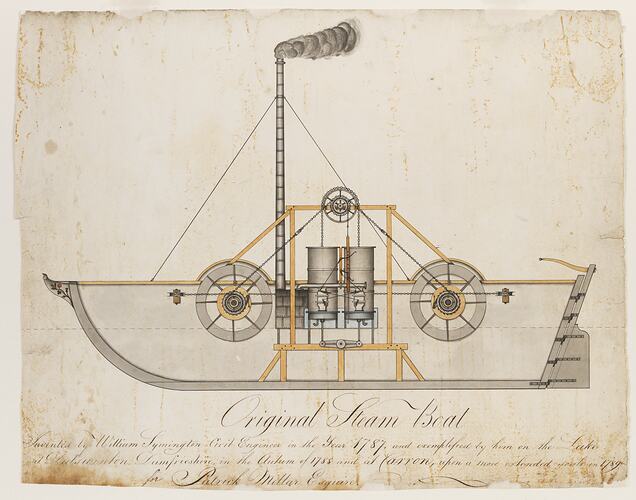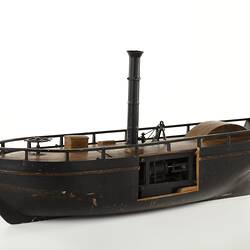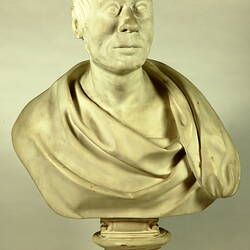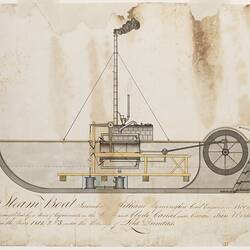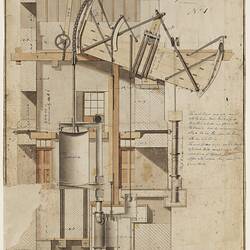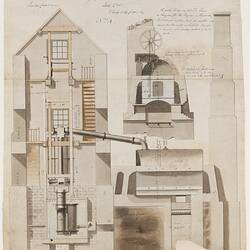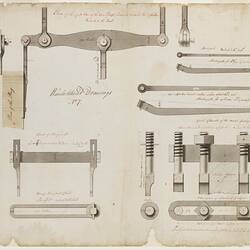Summary
Ink and water-colour technical drawing showing a longitudinal cross-sectional elevation of the first paddlesteamer built by the Scottish engineer and inventor, William Symington, C.E., with assistance from James Taylor and others, in 1787-88. The vessel depicted is an experimental steam-powered paddleboat built for Patrick Miller Esq., a prominent Edinburgh merchant and banker. Late in 1787, Miller commissioned Symington to build a steam engine for the experimental vessel, based on his improved atmospheric condensing engine design, patented in June 1787. The drawing shows the vertical twin-cylinder single-acting engine that was fitted into one side of the double-hulled catamaran-style vessel. The steam boiler shown behind the engine was mounted in the opposite hull, with the two paddle-wheels were mounted in tandem in the gap between the hulls. The design incorporates a system of chains and ratchets proposed in Symington's patent, to transfer the reciprocating motion of the piston rods to a forward rotary motion of the paddle-wheels.
Brass castings for the engine cylinders and valve chests were produced at the foundry of George Watt, in Edinburgh (no direct relation to James Watt), and were then sent to Wanlockhead where Symington was employed as an engineer for a lead mining company. The engine was initially assembled in the mine workshop by William Symington and James Taylor. Additional assistance was provided by two blacksmiths at the mines, Alexander Carlaw and John Hutchinson, and some smaller parts were fabricated by an unnamed local clockmaker. After months of work the engine was finally completed in September 1788 and transported to the country estate of Patrick Miller at Dalswinton, Dumfrieshire, 25 miles (40 km) south of Wanlockhead, for installation in the waiting paddleboat. On 14th October 1788, a public demonstration of the vessel operating under steam was made on Dalswinton Loch, witnessed by Mr Miller and a party of invited guests. It is believed to have been the first demonstration of a practical steam-powered vessel in Britain, and although cumbersome and underpowered, with an estimated output of less than half a horsepower (0.33 kW), it was sufficient to prove that it was possible to safely operate a steam engine in a wooden hulled vessel, and to power a vessel using steam-power alone (or rather atmospheric pressure and a vacuum created by condensing steam). The results were sufficiently promising to encourage Miller to fund the construction of a second paddleboat and further trials on the Forth and Clyde Canal the following year.
The drawing is believed to have been executed from memory by the inventor, around 1828, as an illustration to accompany the pamphlet 'A Brief History of Steam Navigation', which William Symington published in 1829, seeking to secure belated recognition for his role in pioneering steam-powered water transport. The original drawing was brought to Australia by the inventor's son, William Symington Jnr. (c.1802-1867), who emigrated to Victoria in 1855 and settled with his family at Bacchus Marsh. It was donated to Museum Victoria by a descendant of the Symington family.
The original engine from the Dalswinton paddlesteamer is now held in the Science Museum in London. It differs in detail to some of the proportions shown in this drawing; however, the general arrangement is similar. The original engine had bores of 4 inches (101.6 mm) and a stroke of 18 inches (457 mm), while the vessel was 25 feet (7.62 m) long, with a 7 feet (2.13 m) beam.
Description of Content
DRAWING OF ORIGINAL STEAM BOAT. ENGINEERING DRAWING BY WILLIAM SYMINGTON, 1787. FURTHER DOCUMENTATION REQUIRED. TO BE NUMBERED.
Physical Description
Unscaled coloured (black, grey, yellow) technical line drawing with handwritten text underneath. The drawing shows a longitudinal cross-sectional elevation (side view) of a steam powered vessel, with two vertical steam cylinders connected by an endless chain and ratchet mechanicm to two small paddlewheels mounted in tandem fore and aft in the centre of the twin-hulled vessel. A steam boiler and chimney monted on the other side of the boat is partially visible in the background.
More Information
-
Collection Names
-
Collecting Areas
-
Acquisition Information
Cultural Gifts Donation from Dr Graeme R. Symington, by 03 Feb 1993
-
Creator
Mr William Symington Snr, C.E., London, England, Great Britain, circa 1828-1829
Drawing created from memory by William Symington, either in Falkirk, or more likely in London where he moved in 1829, to live out his final years with his daughter and son-in-law, Dr Robert Bowie. -
Inventor
Mr William Symington Snr, C.E., Wanlockhead, Dumfrieshire, Scotland, Great Britain, 1787-1788
-
Place & Date Named
Dalswinton Loch, Dalswinton, Dumfrieshire, Scotland, Great Britain, 14 Oct 1788
-
Past Owner
Mr William Symington Jnr, C.E., Bacchus Marsh, Victoria, Australia, 1855-1867
-
Past Owner
Miss Nancy M. Symington, Bacchus Marsh, Victoria, Australia
Great-granddaughter of William Symington, snr. She owned the drawings prior to passing them on to the donor. -
Individuals Identified
SYMINGTON, WILLIAM
-
Format
Drawing
-
Inscriptions
Watermark: 'J Whatman', 'Turkey Mill', '1828' Handwritten: 'Original Steam Boat / Invented by William Symington Civil Engineer in the Year 1787 and exemplified by him on the Lake / Dalswinton Dumfrieshire, in the Autumn of 1788 and at Carron, upon a more extended scale in 1789 / for Patrick Millar Esquire'
-
Classification
-
Category
-
Discipline
-
Type of item
-
Overall Dimensions
535 mm (Width), 420 mm (Height)
-
References
[Book] Harvey, W.S. & Downs-Rose, G. 1980. William Symington - Inventor and Engine Builder., See plate 17, p.48. Pages
-
Keywords
Atmospheric (Steam) Engines, Boats, Chimneys, Engineers, Inventions, Inventors, Paddlesteamers, Steamboats, Steam Boilers, Steam Engines, Steam Engineering, Steam Navigation
